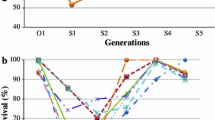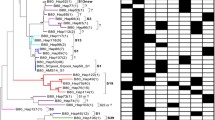Abstract
The total number of lethal equivalents as defined by Morton, Crow and Muller (1956) is a function of three parameters: M, the number of loci at which deleterious mutations can occur, q, the frequency of the deleterious alleles at each locus, and s, their selective value. A new approach based on multi‐generation inbreeding data is outlined and used to infer these three parameters as well as the dominance coefficient, h, in a self‐incompatible species, Brassica rapa L. Germination and flowering data from thirty bud‐selfed lines of fast‐cycling B.rapa were assessed over three generations. Germination and flowering were significantly postponed by inbreeding but germination and flowering success were not so strongly decreased. Estimates of the average s values were obtained but it was not possible to get separate estimates of M and q. For both characters, the average dominance coefficient was particularly low. The number of lethal equivalents at the zygotic level was around two for germination and three for flowering, which, owing to the self‐incompatibility of B.rapa, is an unexpectedly low value. These results may be explained by past biparental inbreeding which in turn may have increased self‐compatibility thus allowing the purging of more deleterious alleles than under strict self‐incompatibility.
Similar content being viewed by others
References
Alström, C., 1993. Extinction of small populations in the presence of lethal alleles. MSc Thesis, University of Wisconsin-Madison.
Barrett, S.C.H. & L.D. Harder, 1996. Ecology and evolution of plant mating. TREE 11: 73–79.
Cabin, R.J., A.S. Evans, D.L. Jennings, D.L. Marshall, R.J. Mitchell & A.A. Sher, 1996. Using bud pollinations to avoid self-incompatibility: implications from studies of three mustards. Can. J. Bot. 74: 285–289.
Charlesworth, D. & B. Charlesworth, 1987. Inbreeding depression and its evolutionary consequences. Ann. Rev. Ecol. Syst. 18: 237–268.
Charlesworth, D., E.E. Lyons & L.B. Litchfield, 1994. Inbreeding depression in two highly inbreeding populations of Leavenworthia. Proc. R. Soc. Lond. B 258: 209–214.
Crow, J.F., 1993. Mutation, mean fitness, and genetic load, pp. 3–42 in Oxford Surveys in Evolutionary Biology, vol. 9 edited by Futuyma, D. and J. Antonovics. Oxford University Press, New York.
De Nettancourt, D., R. Ecochard, M.D.G. Perquin, T. Van der Drift & M. Westerhof, 1971. The generation of new S alleles at the incompatibility locus of Lycopersicum peruvianum Mill. Theor. Appl. Genet. 41: 120–129.
Fisher, R.A., 1949. The Theory of Inbreeding. Oliver and Boyd, Edinburgh.
Fowler, D.P. & Y.S. Park, 1983. Population studies of white spruce. I. Effect of self-pollination. Can. J. For. Res. 13: 1133–1138.
Fu, Y.B. & K. Ritland, 1994. On estimating linkage of marker genes to viability genes controlling inbreeding depression. Theor. Appl. Genet. 88: 925–932.
Gilks, W.R., D.G. Clayton, D.J. Spiegelhalter, N.G. Best, A.J. McNeil, L.D. Sharples & A.J. Kirby, 1993. Modelling complexity: applications of Gibbs sampling in medicine. J.R. Statist. Soc. B 55: 39–52.
Hastings, W.K., 1970. Monte Carlo sampling methods using Markov chains and their applications. Biometrika 57: 97–109.
Hedrick, P.W., 1994. Purging inbreeding depression and the probability of extinction: full-sib mating. Heredity 73: 363–372.
Heywood, J.S., 1993. Biparental inbreeding depression in the self-incompatible annual plant Gaillarda pulchella (Asteraceae). Am. J. Bot. 80: 545–550.
Husband, B.C. & D.W. Schemske, 1996. Evolution of the magnitude and timing of inbreeding depression in plants. Evolution 50: 54–70.
Johnston, M.O. & D.J. Schoen, 1995. Mutation rates and dominance levels of genes affecting total fitness in two Angiosperm species. Science 267: 226–229.
Kang, H., J. Lee & E.V. Nordheim, 1994. Number of lethal loci and lethal equivalents in willow, Salix viminalis. Silvae Genet. 43: 138–145.
Kuhner, M.K., J. Yamato & J. Felseinstein, 1995. Estimating population size and mutation rate from sequence data using Metropolis-Hastings sampling. Genetics 140: 1421–1430.
Koski, V., 1971. Embryonic lethals of Picea abies and Pinus sylvestris. Comm. Inst. For. Fenn. 75: 1–30.
Lee, J.K., M.Lascoux & E.V. Nordheim, 1996a. Numbers of lethal equivalents in human populations: how good are the previous estimates? Heredity 77: 209–216.
Lee, J.K., M. Lascoux, M.A. Newton & E.V. Nordheim, 1998. A study of deleterious gene structure in plants using Markov Chain Monte Carlo. Biometrics. (in press).
Lee, J.K., E.V. Nordheim & H. Kang, 1996b. Inference for lethal gene estimation with application in plants. Biometrics 52: 451–462.
Levin, D.A., 1984. Inbreeding depression and proximity-dependent crossing success in Phlox drummondii. Evolution 38: 116–127.
Metropolis, N., A.W. Rosenbluth, M.N. Rosenbluth, A.H. Teller & E. Teller, 1953. Equations of state calculations by fast computing machine. J. Chem. Phys. 21: 1087–1091.
Morton, N.E., J.F. Crow, & H.J. Muller, 1956. An estimation of the mutational damage in man from data on consanguineous marriages. Proc. Nat. Acad. Sc. USA 42: 855–863.
Namkoong, G. & J. Bishir, 1987. The frequency of lethal alleles in forest tree populations. Evolution 41: 1123–1127.
Nasrallah, J.B. & M.E. Nasrallah, 1986. Molecular biology of self-incompatibility in plants. TIG 21: 239–243.
Nasrallah, J.B. & M.E. Nasrallah, 1993. Pollen-stigma signaling in the sporophytic self-incompatibility response. The Plant Cell 5: 1325–1335.
Nasrallah, M.E., M.K. Kandasamy & J.B. Nasrallah, 1992. A genetically defined trans-acting locus regulates S-locus function in Brassica. The Plant Journal 2: 497–506.
Peck, J. & A. Eyre-Walker, 1997. The muddle about mutations. Nature 387: 135–136.
Ritland, K., 1996. Inferring the genetic basis of inbreeding depression in plants. Genome 39: 1–8.
Savolainen, O., K. Kärkkäinen & H. Kuittinen, 1992. Estimating number of embryonic lethals in conifers. Heredity 69: 308–314.
Simmons, M.J. & J.F. Crow, 1977. Mutations affecting fitness in Drosophila populations. Ann. Rev. Genet. 11: 49–78.
Sorensen, F.C., 1969. Embryonic genetic load in costal Douglas-fir, Pseudotsuga menziesii var. menziesii. Am. Nat. 103: 389–398.
Sved, J.A. & A.N. Wilton, 1989. Inbreeding depression and the maintenance of deleterious genes by mutation: model of a Drosophila chromosome. Genet. Res. Camb. 53: 119–128.
Thomas, D.C., 1992. Fitting genetic data using Gibbs sampling: An application to nevus counts in 38 Utah kindreds. Cytogenet. Cell Genet. 59: 228–239.
Thompson, K.F. & J.P. Taylor, 1971. Self-compatibility in kale. Heredity 27: 459–471.
Williams, P.H. & C.B. Hill, 1986. Rapid-cycling populations of Brassica. Science 32: 1385–1389.
Author information
Authors and Affiliations
Rights and permissions
About this article
Cite this article
Lascoux, M., Lee, J.K. One step beyond lethal equivalents: characterization of deleterious loci in the rapid cycling Brassica rapa L. base population. Genetica 104, 161–170 (1998). https://doi.org/10.1023/A:1003441713325
Issue Date:
DOI: https://doi.org/10.1023/A:1003441713325




